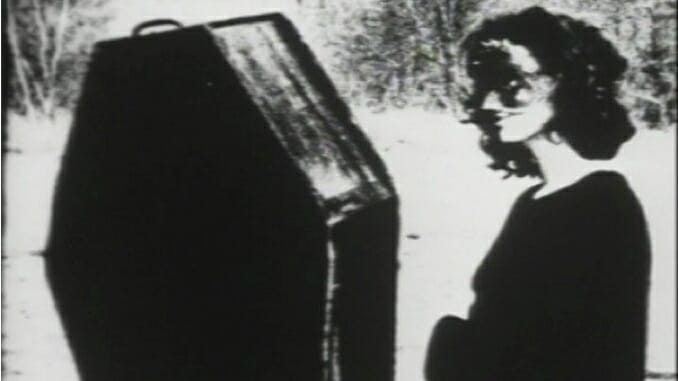Begotten, Tumblr and Gore: 30 Years Later, Merhige’s Movie Remains One of the Most Disturbing Avant-Garde Films Ever Made

Apologies in advance for eliciting an image that is best relegated to a collective amnesia, but who remembers the map of Tumblr? A crude drawing of a series of connecting islands, its borders are largely designated by fandom or cultural affiliation. Regions labeled in Comic Sans vary wildly from “Cats” and “Nutella” to Harry Potter and Doctor Who, with only a small sliver of “Fandom Island” relegated to “Other.”
When recently asked by a former fandom blogger which territory I had occupied in this fictional landscape, I winced.
“I, uh, actually ran a gore blog, so I guess ‘Other,’” I admitted to the woman who had once undoubtedly found herself marooned on the coast of “Shipper Lake.”
Long before Tumblr went through a mass purification, the blogging platform was an effective outlet for teens to examine the seedy underbelly of culture with a guise of relative anonymity. Hardcore porn, violent imagery and grisly details from cold cases were reblogged on a continuous cycle, with fringe bloggers often scouring the internet for shocking images to proliferate the stream of content. When resources seemed to be exhausted where real-life crime and autopsy photos were concerned, it became a morbid pastime to scour horror films for the imagery that titillated this corner of the blogosphere. Particularly when it came to preserving the curated #aesthetic of one’s blog, the texture and composition of film seemed an obvious no-brainer to highlight—all while getting some of the more morally uptight anonymous messages about “honoring the dead” out of our inboxes.
Of the films that made the rounds, Cannibal Holocaust, The Texas Chainsaw Massacre and I Spit on Your Grave were among the most popular. Yet one film saw frenzied circulation unlike any other among this niche of macabre bloggers: E. Elias Merhige’s Begotten. Freely accessible for anyone to watch on YouTube, the brutal and difficult film first wormed its way into my teenage psyche through still images alone. The inky black-and-white frame of a vaguely human entity bleeding from the mouth while stabbing itself quickly got under my skin, and not long after I would watch the dialogue-less, avant-garde meditation on life, death and creation for myself.
Though the film is void of dialogue, it is not without words entirely. It begins with an intertitle containing morbid prose: “Language bearers, Photographers, Diary makers / You with your memories are dead, frozen / Lost in a present that never stops passing / Here lives the incantation of matter / A language forever.” As the deep blackness of the film crackles and gives way to white streaks of exposure, the text continues: “Like a flame burning away the darkness / Life is flesh on bone convulsing above the ground.”
The film then opens on a shuddering figure, gagged and bleeding profusely through several orifices. Their white garb becomes increasingly muddled and heavy with blood, only exacerbated when the figure begins cutting away at internal organs with a straight razor. Raw matter begins falling to the floor of the already decaying one-room shack, blood and other bodily fluids pooling beneath the sufferer’s feet. Though only revealed in the credits, this figure is indeed God killing Himself, the ethereal entity’s dogged efforts in self-sacrifice only punctuated by nauseating squelching noises. Finally, God lies limp in victory, blackened excrement continuing to pile for an excruciating moment after the being’s demise. A gorgeous young woman, Mother Earth, rises from behind the brutal remains of God, walking gracefully around the perimeter of the sordid room before taking it upon herself to masturbate the deceased God-figure, using the resulting ejaculate to artificially inseminate herself. After carrying the offspring to term, Mother Earth gives birth to a disfigured but otherwise full-grown man. Convulsing in a similar manner to a disemboweled God, the Son of Earth is abandoned by his mother to fend for himself. Found by a group of sadistic nomads, he is tortured and burned alive. Spurned by her son’s senseless killing, Mother Earth reincarnates the man and decides to accompany him on his journey this time. Yet when the nomads show up once again, both mother and son are violently assaulted. Mother Earth is raped and disemboweled in front of her injured son, who looks on helplessly before being murdered. They are both buried in a crude grave, which time lapse shows to grow into a lush meadow.
-

-

-

-

-

-

-

-

-

-

-

-

-

-

-

-

-

-

-

-

-

-

-

-

-

-

-

-

-

-

-

-

-

-

-

-

-

-

-

-








































